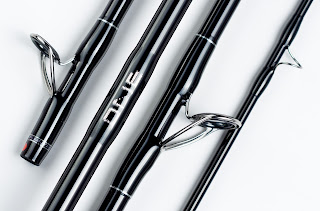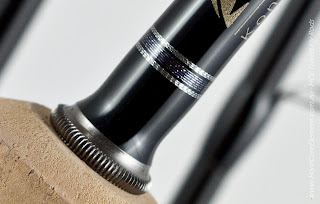CTS
prides itself on being at the leading edge of rod design. focussing on
intensive product development and continuous improvement in their design and
manufacturing processes.
The
following information represents why we at HCE have chosen CTS as our major blank
supplier...
Carbon
Helix Core
 § Superior hoop strength
§ Superior hoop strength
§ Improved response
A single carbon spiral is at the
core of the blank. This type of structure is commonly regarded as the most
effective way of maintaining cross section stability during bending.
Our carbon helix core will minimize cross sectional deformation during loading,
improving power and response.
 In a
flexing situation, the blank is undergoing pressures that can cause it to
change from a round shape to a slightly oval shape.
In a
flexing situation, the blank is undergoing pressures that can cause it to
change from a round shape to a slightly oval shape.
Even a
small 2% reduction in section height caused by these pressures will reduce the
stiffness of the rod by around 10%.
A
non woven fiber can achieve 100% of its tensile and compressive loading, unlike
woven based scrims which exhibit large amounts of fiber crimping resulting in
greatly reduced fiber loading potential.
The higher the loading, the softer the blank will
become, reducing its ability to fight fish. All CTS carbon helix core blanks boast
100% non woven fiber.
All CTS carbon helix core blanks boast 100% non woven fiber.
 A non
woven fiber can achieve 100% of its tensile and compressive loading, unlike
woven based scrims which exhibit large amounts of fiber crimping resulting in
greatly reduced fiber loading potential.
A non
woven fiber can achieve 100% of its tensile and compressive loading, unlike
woven based scrims which exhibit large amounts of fiber crimping resulting in
greatly reduced fiber loading potential.
100%
Carbon Construction
§ Super light weight construction
§ Superior strength
Through
the use of the CTS carbon helix core, blanks are able to boast a true 100%
carbon construction. This ensures response and agility are optimized through
utilizing the lightweight and high strength characteristics that only carbon can
give.
Modulus Replacement Technology (MRT)
 This new
type of construction enables us to place totally different modulus materials at
each part of the blank. Unlike traditional multi modulus systems which lay up
materials of differing modulus materials together, our new Modulus Replacement
Technology is all together different, taking blank manufacture to a new level.
This new
type of construction enables us to place totally different modulus materials at
each part of the blank. Unlike traditional multi modulus systems which lay up
materials of differing modulus materials together, our new Modulus Replacement
Technology is all together different, taking blank manufacture to a new level.
Variable
fit length
§ Reduced section-to-section flat
spots
§ Reduced swing weight
§ Smooth load transfer
The join
lengths between each section within our multi piece blanks are varied according
to the load that they are designed to carry. This ensures flat spots and swing
weights are minimized.
Computer
Aided Engineering CAE
Computer
Aided Engineering has enabled CTS to design precise blank ranges with perfectly
progressive actions through the entire range.
Multi
carbon construction
CTS works
closely with its boutique carbon suppliers to obtain the optimum fiber types
and resin systems to ensure all CTS blanks are at the leading edge in terms of
material development.
Up to
five different types of carbon are used in each blank. Each type is placed at
various parts of the blank to optimize strength and weight.
Internal High Strength ferrule
A high strength ferrule is placed at each join, to
provide superior crush and split resistance.
Target Zero Fibre Alignment
 Fiber alignment along the length of any blank is critical. Even the
smallest deviation in fiber alignment from the axis of load will greatly reduce
the strength of the blank.
All CTS blanks are designed and produced to ensure all fiber is aligned
as near perfect as can be with the load.
Fiber alignment along the length of any blank is critical. Even the
smallest deviation in fiber alignment from the axis of load will greatly reduce
the strength of the blank.
All CTS blanks are designed and produced to ensure all fiber is aligned
as near perfect as can be with the load.

 This image gallery features the CTS Affinity X, Ticks all the boxes for serious swoff action: extra fast taper, fast action, plenty of reserve power below, damn nice to cast big flies with and good pick up and cover prowess.
This image gallery features the CTS Affinity X, Ticks all the boxes for serious swoff action: extra fast taper, fast action, plenty of reserve power below, damn nice to cast big flies with and good pick up and cover prowess.














